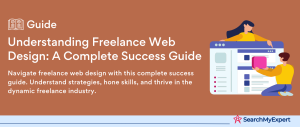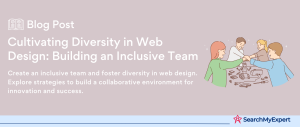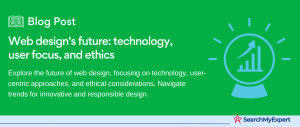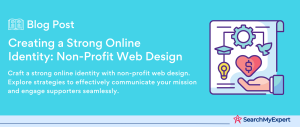Understanding Modern Web Design: The Gateway to Digital Excellence
In today’s rapidly advancing digital era, modern web design stands not just as a craft but as a pivotal element in the online universe. It’s a dynamic blend of aesthetics, functionality, and innovative technology, shaping how we interact with the digital world. But what exactly is modern web design, and why does it hold such significance?
At its core, modern web design is about creating web interfaces that are not only visually appealing but also user-friendly, accessible, and responsive. It’s an art that balances form and function, ensuring websites are not only attractive but also efficient and easy to navigate. This balance is crucial in a world where websites often serve as the first point of contact between a business and its potential customers.
The constant evolution of web design trends and the need to stay updated
The importance of modern web design extends beyond mere appearance. It’s about delivering a seamless user experience, enhancing user engagement, and ultimately, driving business success. A well-designed website can significantly impact user perception, influencing how they interact with the brand and their decision-making process.
Moreover, with the digital landscape continuously evolving, web design trends are in a state of constant flux. Staying updated with these trends is not just beneficial; it’s essential for businesses and web designers alike. This evolution is driven by changes in technology, user behavior, and broader aesthetic preferences, reflecting the ever-changing nature of the internet itself.
Each aspect of modern web design plays a vital role:
- Visual Appeal:
The use of color, typography, and imagery creates an immediate impression, setting the tone for user experience. - Usability:
Intuitive navigation and easy-to-use interfaces ensure that users can find what they need without frustration. - Accessibility:
Designing for inclusivity means ensuring that websites are usable by people of all abilities and disabilities. - Responsive Design:
With a variety of devices in use, from smartphones to desktops, websites must adapt to different screen sizes. - Performance and Speed: Websites must load quickly and run smoothly, as user patience with slow sites is minimal.
- Content Strategy:
Effective web design is supported by high-quality, relevant content that engages and informs users. - SEO Practices: Integrating search engine optimization strategies ensures that the website is not just seen but also ranked favorably by search engines.
Minimalism and White Space
Embracing Minimalism and White Space in Modern Web Design
In the realm of modern web design, minimalism has emerged as a powerful trend, reshaping the way we perceive and interact with websites. This trend is characterized by a philosophy of ‘less is more’, where the focus is on simplicity, clean layouts, and the strategic use of negative space, often referred to as white space.
The Essence of Minimalism
Minimalism in web design is all about stripping away the unnecessary. It involves the use of simple elements, monochromatic or limited color palettes, and ample negative space. This approach leads to designs that are not only aesthetically pleasing but also highly functional. The minimalist trend counters the noise and clutter typical of the internet, providing a refreshing and clear visual experience.
Benefits of Minimalism
- Improved Readability: With fewer distractions, minimalistic designs make it easier for users to read and understand content. The simplicity enhances the clarity of text and images, making the message more powerful.
- Enhanced Focus:
By reducing the number of elements on a page, users’ attention is directed to what’s most important. This focused approach can significantly improve the effectiveness of calls to action and important information. - Optimized User Experience: Minimalism contributes to a smoother user experience. Faster load times, easier navigation, and a more intuitive interface are all outcomes of a minimalist approach.
White Space: The Breathing Room of Web Design
White space, often misunderstood as mere ‘space’, is a critical component of minimalism. It’s the space between elements in a design, including margins, padding, and the space between lines of text. Rather than being ‘wasted space’, white space plays several key roles in web design:
- Enhances Content: White space can frame and highlight key pieces of content, making them stand out and easier to digest.
- Improves Readability:
Ample space around text and between lines improves readability and reduces eye strain. - Creates Balance and Harmony: White space is essential for creating a balanced and harmonious layout, which is pleasing to the eye and makes for a more enjoyable browsing experience.
- Increases User Engagement:
By making the design more digestible and less overwhelming, white space can increase the time users spend on a site and their willingness to interact with the content.
The Rise of Bold Typography and Oversized Fonts in Web Design
In recent years, the use of bold typography and oversized fonts has become a standout trend in modern web design. This approach reflects a shift towards more assertive, attention-grabbing elements that make a powerful statement the moment a user lands on a page.
The popularity of Oversized Typography
Oversized typography is increasingly popular for several reasons. It makes an immediate impact, ensuring key messages are not just seen but felt. This trend is particularly effective for websites aiming to establish a strong brand presence or convey a powerful message succinctly. Large, bold fonts can convey a sense of confidence and modernity, which resonates with contemporary audiences.
Impact of Bold Fonts
- Attention-grabbing:
Large, bold fonts capture attention quickly, making them perfect for headlines, brand names, and essential calls to action. - Creating Hierarchy:
In web design, hierarchy is crucial. Oversized fonts help establish a clear order of importance on a page, guiding the user’s eye to the most critical information first. - Enhancing Visual Appeal:
Bold typography can be a design element in its own right. When used creatively, it adds an artistic flair to a website, enhancing its overall aesthetic.
Examples of Effective Use of Oversized Typography
Several websites have skillfully implemented oversized typography to create a strong visual impact:
- E-commerce Sites:
Many e-commerce platforms use large, bold fonts for product names and prices, making it easy for users to identify key information quickly. - Landing Pages: Startups and tech companies often use oversized typography on landing pages to make a strong, memorable statement about their product or service.
- Digital Magazines and Blogs: Online publications frequently employ bold, large fonts for article titles and headers, drawing readers into the content.
Micro-Interactions and Animations: Enhancing User Engagement in Web Design
The Role of Micro-Interactions
Micro-interactions are small, functional animations or effects that occur as a result of user interaction with a website. These can be as simple as a button changing color when hovered over or a small animation that plays when a user completes an action. The primary role of micro-interactions is to create engaging, intuitive, and satisfying user experiences. They provide immediate feedback to users, making the interaction feel more human and responsive.
Micro-Animations: Adding Dynamism
Micro-animations are brief animations that help guide users through their interactions with a website. They add a layer of dynamism and interactivity, making the user experience more enjoyable and engaging. These animations can be used to:
- Guide User Focus: Animations can direct users’ attention to important elements or changes on a page.
- Enhance Feedback:
They provide visual feedback for user actions, such as a button appearing depressed when clicked. - Create a Sense of Continuity:
Smooth transitions between pages or elements maintain a sense of continuity and flow.
Examples of Micro-Interactions and Animations
- Loading Animations:
These keep users engaged during loading times, reducing perceived wait times. - Hover Effects: Visual changes when users hover over elements, enhancing the interactivity of the site.
- Scrolling Animations: Elements that animate or change as the user scrolls through a page, adding visual interest.
Interactive 3D Models and Content in Web Design
Integrating 3D Models and Content
The integration of 3D models and content in web design is a growing trend, offering a new dimension of interactivity and visual appeal. 3D elements can make a website stand out by providing a more immersive and engaging user experience. They are particularly effective in:
- Product Visualization: 3D models allow users to explore products from every angle, improving understanding and engagement.
- Storytelling: They can be used to tell stories in a more interactive and engaging way, making content more memorable.
- Enhancing User Experience:
3D content can transform a flat, static page into a dynamic, engaging experience.
Augmented Reality (AR) and Virtual Reality (VR) in Web Design
The use of AR and VR technologies in web design is an exciting development. These technologies offer unique ways to engage users:
- Augmented Reality:
AR allows users to see how products might look in their own environment, enhancing the decision-making process. - Virtual Reality: VR creates fully immersive experiences, ideal for virtual tours, simulations, or games.
Nostalgic and Retro Design Elements in Modern Web Design
The digital world, ever-evolving, has recently seen a charming resurgence of nostalgic design elements. This trend, which borrows from past eras, brings a unique blend of the old and new to the forefront of web design.
Resurgence of Nostalgic Design Elements
Nostalgic design elements are those that evoke the styles and aesthetics of previous decades. The resurgence of these elements is a nod to the past, bringing a sense of familiarity and warmth to modern web design. This trend is not about mere replication but about integrating retro influences with contemporary design principles to create something both familiar and fresh.
Vintage Fonts, Color Palettes, and Graphic Styles
- Vintage Fonts:
The use of vintage or retro-inspired fonts can immediately transport users to a different time. These fonts are often used for headings and titles to grab attention and set the tone. - Color Palettes: Retro color palettes, often featuring muted tones or specific color combinations reminiscent of past decades, add a unique character to websites.
- Graphic Styles: Incorporating graphic styles from the 60s, 70s, 80s, or 90s, such as pixel art, neon colors, or minimalist line art, can add a distinctive flair.
Impact of Nostalgic Elements on Web Design
- Evoking Emotions: Nostalgic elements can evoke a sense of nostalgia in users, creating an emotional connection with the website. This can be particularly effective for brands looking to establish a bond with their audience.
- Building Brand Identity:
For brands with a history or those wishing to convey certain values or aesthetics associated with a past era, retro design elements can be a powerful tool in building a unique brand identity. - Connecting with Target Audiences: Nostalgic design can resonate deeply with target audiences who have a fondness for or connection to the specific era being referenced. This can help in creating a loyal customer base that feels a personal connection to the brand.
Embracing Technology and Innovation in Web Design
In the fast-paced and ever-evolving world of web design, staying ahead of the curve requires embracing new technologies and innovations. Technologies like AI, voice search, and chatbots are not just trends; they are revolutionizing the way we interact with the digital world.
Incorporating New Technologies
- Artificial Intelligence (AI): AI in web design can tailor user experiences by analyzing user behavior and preferences. This leads to more personalized content, product recommendations, and even tailored user interfaces.
- Voice Search Optimization:
With the growing use of voice assistants, optimizing websites for voice search has become crucial. It involves designing content that aligns with conversational language and natural speech patterns. - Chatbots and Virtual Assistants:
Implementing chatbots and virtual assistants on websites provides users with instant assistance, enhances engagement, and improves customer service efficiency.
Personalizing User Experiences
The ultimate goal of integrating these technologies is to create more personalized and seamless user experiences. AI can dynamically adjust content and layouts based on user data, voice search optimization allows for more natural and convenient user interactions, and chatbots offer real-time, personalized assistance. These innovations make websites more intuitive and user-friendly, significantly enhancing the overall user experience.
Ongoing Learning and Adaptation
- Keeping Pace with Technology:
The field of web design is constantly changing, with new technologies emerging regularly. Web designers must stay informed about these developments to ensure their skills and knowledge are up-to-date. - Adapting to User Expectations:
As users become more accustomed to advanced technologies in their daily lives, their expectations for website functionality and interactivity increase. Designers must continuously innovate to meet these evolving expectations. - Lifelong Learning:
The key to success in web design is lifelong learning and adaptation. Whether it’s taking online courses, attending workshops, or experimenting with new tools, continuous learning is essential.
Conclusion
Embracing technology and innovation is crucial for staying relevant in the field of web design. By integrating AI, voice search optimization, and chatbots, designers can create more personalized, efficient, and user-friendly experiences. However, this requires a commitment to ongoing learning and adaptation, ensuring that designers are always ready to meet the challenges of the ever-changing digital landscape.
Let our Web Design Company craft your digital dream.
Table of Contents
Toggle






